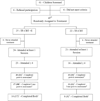Engaging foster parents in treatment: a randomized trial of supplementing trauma-focused cognitive behavioral therapy with evidence-based engagement strategies
- PMID: 24791605
- PMCID: PMC4160402
- DOI: 10.1016/j.chiabu.2014.03.020
Engaging foster parents in treatment: a randomized trial of supplementing trauma-focused cognitive behavioral therapy with evidence-based engagement strategies
Abstract
The goal of this study was to examine the impact of supplementing Trauma-focused Cognitive Behavioral Therapy (TF-CBT; Cohen et al., 2006) with evidence-based engagement strategies on foster parent and foster youth engagement in treatment, given challenges engaging foster parents in treatment. A randomized controlled trial of TF-CBT standard delivery compared to TF-CBT plus evidence-based engagement strategies was conducted with 47 children and adolescents in foster care and one of their foster parents. Attendance, engagement, and clinical outcomes were assessed 1 month into treatment, end of treatment, and 3 months post-treatment. Youth and foster parents who received TF-CBT plus evidence-based engagement strategies were more likely to be retained in treatment through four sessions and were less likely to drop out of treatment prematurely. The engagement strategies did not appear to have an effect on the number of canceled or no-show sessions or on treatment satisfaction. Clinical outcomes did not differ by study condition, but exploratory analyses suggest that youth had significant improvements with treatment. Strategies that specifically target engagement may hold promise for increasing access to evidence-based treatments and for increasing likelihood of treatment completion.
Keywords: Child trauma; Child welfare; Engagement; Foster care; TF-CBT; Trauma-focused Cognitive Behavioral Therapy.
Copyright © 2014 Elsevier Ltd. All rights reserved.
Figures



Similar articles
-
Effectiveness of Task-Shifted Trauma-Focused Cognitive Behavioral Therapy for Children Who Experienced Parental Death and Posttraumatic Stress in Kenya and Tanzania: A Randomized Clinical Trial.JAMA Psychiatry. 2020 May 1;77(5):464-473. doi: 10.1001/jamapsychiatry.2019.4475. JAMA Psychiatry. 2020. PMID: 31968059 Free PMC article. Clinical Trial.
-
Treatment processes and demographic variables as predictors of dropout from trauma-focused cognitive behavioral therapy (TF-CBT) for youth.Behav Res Ther. 2018 Aug;107:10-18. doi: 10.1016/j.brat.2018.05.008. Epub 2018 May 23. Behav Res Ther. 2018. PMID: 29800623 Free PMC article.
-
Stepped Care Versus Standard Care for Children After Trauma: A Randomized Non-Inferiority Clinical Trial.J Am Acad Child Adolesc Psychiatry. 2022 Aug;61(8):1010-1022.e4. doi: 10.1016/j.jaac.2021.12.013. Epub 2022 Jan 12. J Am Acad Child Adolesc Psychiatry. 2022. PMID: 35032578 Free PMC article. Clinical Trial.
-
Trauma-focused cognitive-behavioral therapy for children and adolescents: assessing the evidence.Psychiatr Serv. 2014 May 1;65(5):591-602. doi: 10.1176/appi.ps.201300255. Psychiatr Serv. 2014. PMID: 24638076 Free PMC article. Review.
-
Trauma-focused Cognitive Behavior Therapy for Traumatized Children and Families.Child Adolesc Psychiatr Clin N Am. 2015 Jul;24(3):557-70. doi: 10.1016/j.chc.2015.02.005. Epub 2015 Apr 22. Child Adolesc Psychiatr Clin N Am. 2015. PMID: 26092739 Free PMC article. Review.
Cited by
-
Interventions targeting the mental health and wellbeing of care-experienced children and young people in higher-income countries: Evidence map and systematic review.Syst Rev. 2023 Jul 1;12(1):111. doi: 10.1186/s13643-023-02260-y. Syst Rev. 2023. PMID: 37393358 Free PMC article.
-
A meta-analysis of dropout from evidence-based psychological treatment for post-traumatic stress disorder (PTSD) in children and young people.Eur J Psychotraumatol. 2021 Aug 5;12(1):1947570. doi: 10.1080/20008198.2021.1947570. eCollection 2021. Eur J Psychotraumatol. 2021. PMID: 34377359 Free PMC article. Review.
-
Access to best-evidenced mental health support for care-experienced young people: Learnings from the implementation of cognitive therapy for PTSD.Br J Clin Psychol. 2025 Mar;64(1):63-85. doi: 10.1111/bjc.12471. Epub 2024 Jul 16. Br J Clin Psychol. 2025. PMID: 39012021 Free PMC article.
-
Lost in Transition? Evidence-Based Treatments for Adolescents and Young Adults with Posttraumatic Stress Disorder and Results of an Uncontrolled Feasibility Trial Evaluating Cognitive Processing Therapy.Clin Child Fam Psychol Rev. 2020 Mar;23(1):122-152. doi: 10.1007/s10567-019-00305-0. Clin Child Fam Psychol Rev. 2020. PMID: 31620891 Review.
-
Patterns of Caregiver Factors Predicting Participation in Trauma-Focused Cognitive Behavioral Therapy.J Child Adolesc Trauma. 2017 Jul 15;12(1):97-106. doi: 10.1007/s40653-017-0177-5. eCollection 2019 Mar. J Child Adolesc Trauma. 2017. PMID: 32318183 Free PMC article.
References
-
- Achenbach TM. Manual for the Child Behavior Checklist: 4–18 and 1991 Profile. Burlington, VT: University of Vermont, Department of Psychiatry; 1991.
-
- Achenbach TM, Rescorla LA. Manual for the ASEBA School-Age Forms & Profiles. Burlington, VT: University of Vermont, Research Center for Children, Youth, & Families; 2001.
-
- American Psychiatric Association. Diagnostic and Statistical Manual of Mental Disorders: DSM-IV TR. Vol. 943. Washington, DC: American Psychiatric; 2000.
-
- Attkisson CC, Zwick R. The client satisfaction questionnaire: Psychometric properties and correlations with service utilization and psychotherapy outcome. Evaluation and Program Planning. 1982;6:299–314. - PubMed
-
- Barkham M, Shapiro DA, Hardy GE, Rees A. Psychotherapy in two-plus-one sessions: Outcomes of a randomized controlled trial of cognitive-behavioral and psychodynamic-interpersonal therapy for subsyndromal depression. Journal of Consulting and Clinical Psychology. 1999;67:201–211. - PubMed
Publication types
MeSH terms
Grants and funding
LinkOut - more resources
Full Text Sources
Other Literature Sources
Medical
Miscellaneous

